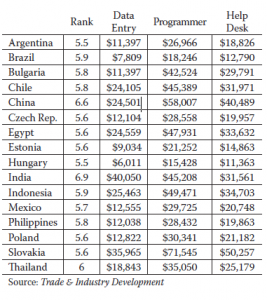Near-shoring (also nearshoring) means moving jobs to a nearby foreign country. It is part of the “X-shoring” constellation of terms that include off-shoring (sending work to an overseas location), multishoring (sending outsourced work to several overseas locations based on the job to be done and the relevant skills available), and two-shoring (using both an offshore location and a domestic one).
Near-shoring should be part of a company’s global strategic considerations because it can generate many direct material benefits, depending on market conditions:
- It allows a firm to upsize or downsize and to spread risk to other parts of the production chain.
- Wage and costs differentials in near-shore countries make the company more competitive in the home market.
- Nearby countries may have higher-quality workers with multilingual capability.
- Rather than extend operations to a country around the world, a company that employs near-shoring can reduce costs and time to market because of the closer proximity to the home market.
- Time-zone advantages mean easier synchronous communication.
- Nearby markets open new consumer markets.
The question facing owners and managers is how to select a near-shore location. This selection usually is usually made through a high-medium-low market selection matrix for making comparisons. Considerations include size and composition of the near-shore market; economic conditions such as growth rate, tariffs, and trading blocs that the country is part of; labor-market factors, such as skilled employees, wage costs, and employee protection regulation; infrastructure issues such as transportation, electricity, and telecommunications; risk factors such as susceptibility to natural disasters; political stability and corruption; and intellectual property protection.
Especially important for near-shoring decisions are wage costs in important labor sectors. Using the rankings of the top near-shoring destinations from BusinessWeek and comparative salaries from Overseas Digest, an owner/manager of an IT company may want to consider the following near-shoring options:

Bibliography:
- Atlantic Canada Opportunities Agency, Nearshoring Industry in Atlantic Canada (Atlantic Canada Opportunities Agency, 2007);
- Stefan Bock, “Supporting Offshoring and Nearshoring Decisions for Mass Customization Manufacturing Processes,” European Journal of Operational Research (v.184/2, 2008);
- “International Salary Report,” Overseas Digest, www.overseasdigest.com (cited March 2009);
- “Nearshoring: A Competitive Advantage in a Global Economy,” Trade & Industry Development, www.tradeandindustrydev.com (cited March 2009);
“Top Countries for Outsourcing,” BusinessWeek, bwnt.businessweek.com (cited March 2009).
This example Near-Shoring Essay is published for educational and informational purposes only. If you need a custom essay or research paper on this topic please use our writing services. EssayEmpire.com offers reliable custom essay writing services that can help you to receive high grades and impress your professors with the quality of each essay or research paper you hand in.




